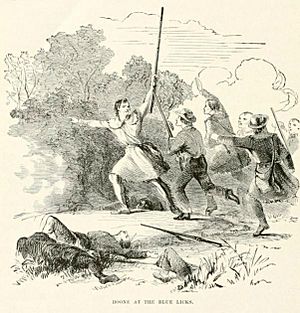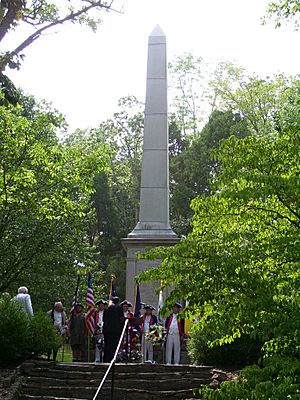Battle of Blue Licks facts for kids
Quick facts for kids Battle of Blue Licks |
|||||||
|---|---|---|---|---|---|---|---|
| Part of the American Indian Wars and American Revolutionary War | |||||||
 Lieutenant Colonel Daniel Boone rallying his men for an attack against indigenous warriors and Loyalists in the Battle of Blue Licks |
|||||||
|
|||||||
| Belligerents | |||||||
Loyalist Americans Indians |
|||||||
| Commanders and leaders | |||||||
| John Todd †, Stephen Trigg †, Daniel Boone, Robert Patterson Lt.James Felix McGuire |
William Caldwell, Alexander McKee, Simon Girty |
||||||
| Strength | |||||||
| 182 militia | 300 Indians, 50 rangers |
||||||
| Casualties and losses | |||||||
| 72 killed, 11 captured |
7 killed 10 wounded. |
||||||
The Battle of Blue Licks was a major fight during the American Revolutionary War. It happened on August 19, 1782. This battle was one of the last big clashes of the war. It took place almost a year after a key event called the Yorktown surrender, which mostly ended the war in the eastern parts of America.
Near the Licking River in what is now Kentucky, about 50 Loyalists (Americans who supported the British) and 300 Native American warriors surprised and defeated 182 Kentucky militiamen. This was the last major win for the Loyalists and Native Americans during the fighting on the frontier.
Contents
Why the Battle Happened
Caldwell's Frontier Expedition
Even though the main British army had given up at Yorktown in 1781, fighting kept going on the western frontier. British soldiers at Fort Detroit helped Native American groups north of the Ohio River. These groups wanted to push American settlers out of what is now Kentucky and West Virginia.
In July 1782, a large meeting took place. Many Native American nations, like the Shawnee, Delawares, and Wyandots, gathered. They planned a big attack on American settlements. About 150 British rangers led by Captain William Caldwell joined them. Around 1,100 Native American warriors also took part. This was one of the biggest forces sent against American settlements during the war.
However, this large attack was called off. Scouts reported that George Rogers Clark, an American commander, was planning to invade the Ohio Country. Native Americans feared Clark greatly. Caldwell's army went back to prepare for Clark's invasion, but it never happened. Most of the Native American warriors then returned to their homes.
The Attack on Bryan Station
Captain Caldwell and about 50 Loyalists, along with 300 Native American warriors, then crossed the Ohio River into Kentucky. They hoped to surprise and destroy the settlement of Bryan Station. But the settlers found out about them and quickly went inside their strong fort.
Caldwell's force surrounded Bryan Station on August 15. They killed the settlers' animals and ruined their crops. But after two days, they left. They had learned that Kentucky militiamen were on their way. Five Native Americans were killed and two were hurt during this short attack.

The Kentucky militiamen arrived at Bryan Station on August 18. There were about 47 men from Fayette County and 135 from Lincoln County. Colonel John Todd was the highest-ranking officer and in charge. He was helped by Lieutenant Colonel Daniel Boone, a famous frontiersman.
The militiamen had to decide: should they chase the attackers right away, or wait for more soldiers? Daniel Boone thought they should wait for Colonel Benjamin Logan, who was only a day away with more men. But others wanted to act immediately. They pointed out that the enemy was already 40 miles ahead. Boone felt he had to go along with the group. So, the Kentuckians rode out on horseback.
The Battle at Blue Licks
On the morning of August 19, the Kentuckians reached the Licking River. This area was known for a spring and a salt lick. They saw a few Native American scouts watching them from across the river. Behind the scouts was a hill where the river curved around.
Colonel Todd held a meeting. He asked Daniel Boone, who knew the woods best, what he thought. Boone said he was suspicious. The Native Americans had left a very clear trail. He felt they were trying to lead the Kentuckians into a trap.
Major Hugh McGary, known for being a fierce fighter but also hot-headed, demanded an immediate attack. When no one listened, he rode his horse across the river. He shouted, "Those who aren't cowards, follow me!" The men quickly followed McGary, and the officers went too, hoping to get things organized. Boone sadly said, "We are all slaughtered men," and crossed the river.
Most of the men got off their horses and formed a battle line. They moved up the hill. Todd and McGary were in the middle, Trigg on the right, and Boone on the left. Just as Boone had thought, Caldwell's force was waiting. They were hidden in ditches on the other side of the hill.
When the Kentuckians reached the top, the Native Americans opened fire. Their shots were very accurate and caused a lot of damage. After only five minutes, the middle and right parts of the Kentuckians' line fell back. Only Boone's men on the left managed to push forward. Colonel Todd and Lieutenant Colonel Trigg, who were easy targets on horseback, were shot and killed.
The Kentuckians started to run back down the hill. They fought hand-to-hand with Native Americans who had moved around to their sides. Major McGary rode to Boone's group and told him everyone was running away. He said Boone was now surrounded. Boone ordered his men to retreat. He grabbed a horse that had no rider. He told his 23-year-old son, Israel Boone, to get on it. Suddenly, Israel fell to the ground, shot in the neck. Boone realized his son was dead. He got on the horse and joined the retreat. Caldwell's force had lost seven killed and ten wounded in the ambush.

What Happened After
Even though he wasn't in the battle, George Rogers Clark was blamed for the disaster at Blue Licks. He was the senior commander in Kentucky. In response, Clark led a revenge attack across the Ohio River in November. His force had over 1,000 men, including Benjamin Logan and Daniel Boone.
The Kentuckians destroyed five empty Shawnee villages. These villages were on the Great Miami River. This was the last big attack of the American Revolution. No battles happened because the Shawnees did not fight. They moved back to their villages on the Mad River.
Years later, the Native American villages on the Mad River were destroyed by Benjamin Logan. This happened at the start of the Northwest Indian War.
Legacy of the Battle
The place where the Battle of Blue Licks happened is now a special park. It is called Blue Licks Battlefield State Park. It is located on U.S. Route 68 between Paris and Maysville.
The park has a tall granite monument, burial grounds, and a museum. Every August, on the weekend closest to the 19th, people hold a re-enactment and a special service to remember the battle.

